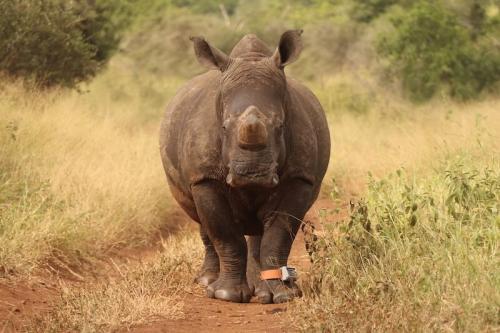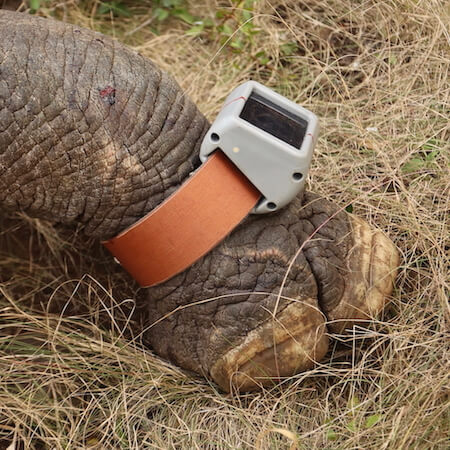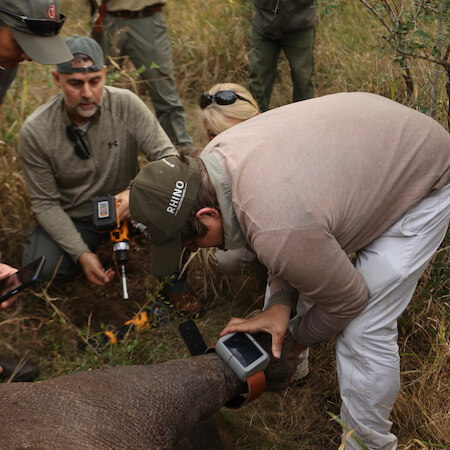 In the war on rhino poaching, the good guys are very literally outgunned by the bad.
In the war on rhino poaching, the good guys are very literally outgunned by the bad.
The poaching gangs are well-organised, well-funded and well-connected, tipping the odds in favour of rhino extinction. Fortunately, there’s still a chance that technology can save them.
Thanda Safari in KwaZulu Natal is one of the latest Big Five game reserves to install an artificial intelligence system that tracks individual rhinos, learns their behaviour, and sends an alert of potential danger.
The Rhino Watch system is a South African invention from Rouxcel Technology, with founder and owner SP le Roux developing the hardware, the electronics and the AI algorithms himself.
 The technology sits in a leg-collar fitted on each animal to send signals to a network of base stations that give 100% coverage of their terrain. But the AI embedded in each collar doesn’t just show their location. It measures various undisclosed metrics to analyse and learn behavioural patterns specific to each rhino so it can flag different or distressing situations. ‘Abnormal’ activity doesn’t only include poaching. Alerts can be triggered by fighting, giving birth or illness, with instant messages sent to a ranger’s phone pinpointing the precise location via GPS. The system can also be used to guide a drone with thermal imaging capabilities to the GPS coordinates to investigate ahead of the rangers.
The technology sits in a leg-collar fitted on each animal to send signals to a network of base stations that give 100% coverage of their terrain. But the AI embedded in each collar doesn’t just show their location. It measures various undisclosed metrics to analyse and learn behavioural patterns specific to each rhino so it can flag different or distressing situations. ‘Abnormal’ activity doesn’t only include poaching. Alerts can be triggered by fighting, giving birth or illness, with instant messages sent to a ranger’s phone pinpointing the precise location via GPS. The system can also be used to guide a drone with thermal imaging capabilities to the GPS coordinates to investigate ahead of the rangers.
Thanda Safari had previously used other foot collars to monitor its black and white rhinos, but limitations such as telemetry units needing line-of-sight demanded a more sophisticated solution.
“This system is crucial in helping us catch poachers in the act,” said Mariana Venter, Thanda Safari’s wildlife operations coordinator. “Additionally, it generates valuable data for tracking rhino movements, monitoring their health and all-round wellbeing, enabling us to learn more about their habitats and differing home ranges.”
 For every reserve using the collars, Le Roux installs a LoRa (long range) wireless network using low-power gateways to pick up the signals and relay them to the rangers. “When I do a network design I try to give the least amount of base stations to provide 100% coverage. To achieve that you have to put them on very specific points of the property, so I do a simulation of the property with network propagation models, and these models are not theoretical any more - we’ve optimised them over many years of real-world rhino data so you can trust the model. You can have a very big property, but if there’s a mountain in the middle then you only need one or two gateways and you end up with a super cheap network for 200 animals. Whereas if you have lots of deep valleys and mountains you’re in for a bit more,” he says.
For every reserve using the collars, Le Roux installs a LoRa (long range) wireless network using low-power gateways to pick up the signals and relay them to the rangers. “When I do a network design I try to give the least amount of base stations to provide 100% coverage. To achieve that you have to put them on very specific points of the property, so I do a simulation of the property with network propagation models, and these models are not theoretical any more - we’ve optimised them over many years of real-world rhino data so you can trust the model. You can have a very big property, but if there’s a mountain in the middle then you only need one or two gateways and you end up with a super cheap network for 200 animals. Whereas if you have lots of deep valleys and mountains you’re in for a bit more,” he says.
The signals are integrated into EarthRanger software, a reserve management platform that conservation areas can use for free. That shows the location of all the rhinos on a central dashboard, although the location ping rate is normally set to just one or twice a day to conserve the collars’ battery power. If an alert is triggered, the collar can be set to ping in real time so a helicopter or vehicles can hone in on the signal.
The battery in each collar lasts for about two years, by which time the unit is so battered that the whole thing must be replaced.
 Le Roux won’t disclose how many rhino he has collared, but he’s working in more than 20 reserves with networks spanning more than 250,000 hectares.
Le Roux won’t disclose how many rhino he has collared, but he’s working in more than 20 reserves with networks spanning more than 250,000 hectares.
Although an alert may come too late to save a targeted rhino, Le Roux says the system is still enormously valuable. “Quite often poachers will come into a reserve and camp for a week and shoot three, four or five rhino without you even knowing they’re there. So if they shoot the first one you will lose that one, but then you’re onto a fresh track and you’ll catch them for sure. So you've lost one, but how many did you save? Those are the things you can count,” he says.
The system also has other benefits. Often the alerts are triggered by injuries to the rhinos that can then be treated by a vet. “We had a buffalo rip open the back leg of a rhino and we got a red alert for that. Often if there was no veterinary intervention the animals would have died,” Le Roux says.
The system has the power of deterrence too, since the teams will tell the reserve staff and local communities how it works and how quickly poachers can be caught. One reserve in Limpopo had poachers making incursions almost monthly in search of its rhino, but after installing this system it’s been three years without a single incident.
Donations Welcome
What’s preventing broader use of Rouxcel’s AI-based anti-poaching system isn’t scepticism, since conservationists are convinced about its value. It’s a question of cost, even though Le Roux has kept the fee down to about R15,000 per collar, plus the network installation. “We have so many people phoning and saying they’re losing animals but they don’t have the cash for it. Now it’s just a matter of funding, which is why we’re trying to solve that last piece of the problem,” he says.
His goal is to make it completely free, so he recently established the Rhino Custodians Foundation to attract funding and sponsorship. As a registered organisation, donations are tax deductible. Click here for details.
First published in Brainstorm magazine. Photos: Christian Sperka